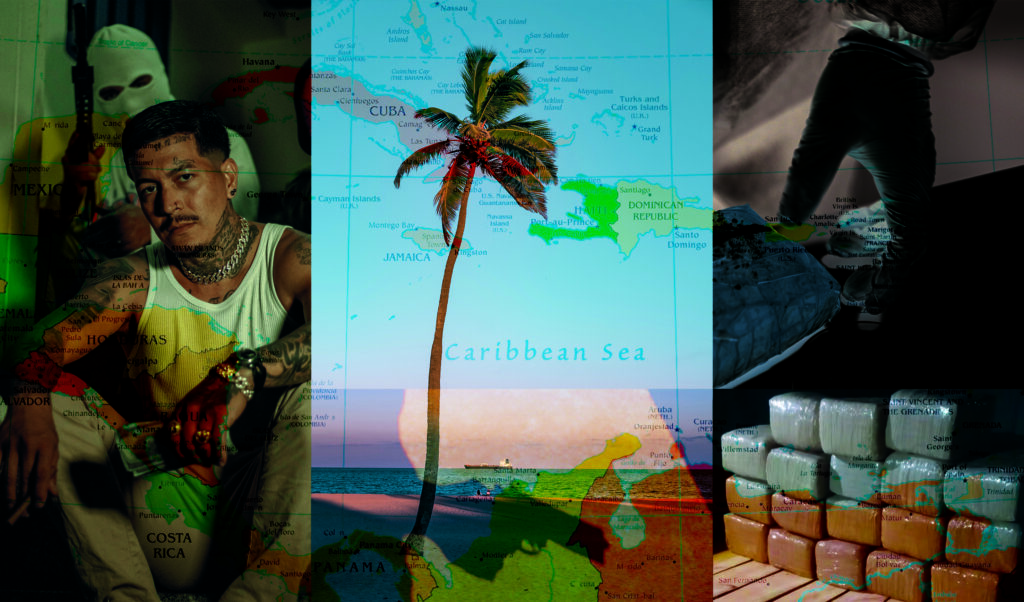Violence and Organized Crime Threaten the Caribbean
The Caribbean is facing an unprecedented wave of violence and organized crime. The proliferation of arms, narcotrafficking, and the influence of transnational criminal networks are increasing homicide rates in countries such as Jamaica, Guyana, St. Lucia, and Trinidad and Tobago. According to the July report Caribbean Gangs, published by the United Nations Office on Drugs and Crime (UNODC), this region is an epicenter of violence.
The report states that the increase in violence is related to the growth of gangs and criminal organizations, which deepen corruption and weaken institutions, creating a climate of impunity that favors the expansion of organized crime. Narcotrafficking is the main driver behind this violence, affecting the stability of Caribbean countries.
The region is the scene of clashes between local and transnational criminal groups, which fight for control of strategic routes and benefit from the easy acquisition of weapons. According to UNODC, impunity, corruption, and lack of transparency allow these organizations to operate on a large scale, connecting North America, South America, and Europe in drug and arms trafficking.
Colombian and Mexican criminal organizations play an important role in narcotrafficking in the Caribbean. They collaborate with local groups while Venezuelan networks control gold and contraband trafficking in the Dutch Caribbean and Trinidad and Tobago, InSight Crime, an organization dedicated to the study of organized crime in Latin America, indicated.
Since the pandemic, gun violence has increased, especially among young people, UNODC says. In 2022, the Turks and Caicos Islands, a key narcotrafficking hotspot, recorded a 100 percent increase in homicides. Jamaica had a rate of 52.9 homicides per 100,000 inhabitants, St. Lucia reached 42.3, and Trinidad and Tobago and Guyana followed the trend, with 22 percent and 36 percent respectively.
In the face of this challenge, regional cooperation is key. The Caribbean Community Implementation Agency for Crime and Security promotes collective responses among member countries. In addition, the United States contributes significantly to security operations in the region, the UNODC report said.
Guyana
Guyana has been a key point for South American drug trafficking for decades, the report said. On the border with Venezuela, Venezuelan criminal groups form alliances with local Guyanese gangs to expand their operations in rural areas of Guyana.
On September 1, Guyanese authorities seized more than 3,600 kilograms of cocaine in a jungle near the Venezuelan border, hidden in underground bunkers near an illegal airstrip in Region One (Barima-Waini), Argentine news site Infobae reported. Authorities frequently find improvised submarines in that region.
Thanks to U.S. collaboration through the Caribbean Basin Security Initiative (CBSI), Guyana is strengthening its capabilities to combat narcotrafficking. However, corruption, lack of resources, and the sophistication of criminal networks continue to be major challenges for the country. The CBSI is a security alliance between the United States and 13 Caribbean countries.
“If urgent action is not taken to support these countries, they could spiral further into violence and crime; further destabilizing the region,” Jorge Serrano, an advisor to Peru’s Congressional Intelligence Commission, told Diálogo on September 28. “In the case of Haiti, the assassination of President Jovenel Moïse at the hands of criminal groups and foreign mercenaries is a clear example of what could happen.”
Trinidad and Tobago
Trinidad and Tobago is another key point for cocaine and cannabis trafficking. Its proximity to Venezuela and its location outside the hurricane belt facilitate the arrival of drugs from Venezuela, Guyana, and Suriname. Drugs are redistributed on the high seas or in ports, but limited surveillance and poor cooperation from Venezuela make seizures difficult, the UNODC report said.
As of August 26, 2024, Trinidad and Tobago recorded 413 homicides, surpassing the previous five years. With a murder rate of 26 per 100,000 inhabitants, it surpasses Colombia and Mexico and is projected to reach 635 murders by the end of the year, surpassing the 605 in 2022, InSight Crime indicated.
National Security Minister Fitzgerald Hinds said on September 11 that violence not only increases organized crime within the country, but also “affects the economy and social cohesion.” He added that Trinidad and Tobago “continues to face major challenges in detecting and interdicting narcotics,” Trinidad and Tobago Newsday reported.
“The high levels of violence faced by these countries are alarming, leaving them vulnerable to organized crime. This context represents an even greater danger, as governments could be co-opted by these gangs or collapse, unable to control the growing spiral of violence,” Serrano said. “If this happens, there is a risk that they will become criminal states, as is happening in Venezuela.”
“Venezuela has become a “narco-state,” supported by Cuba, Russia, and Iran,” Serrano continued. “These nations have geostrategic interests in facilitating narcotrafficking and money laundering, and weakening the social, economic, and military capabilities of some countries in the region, to promote increased drug flows to the U.S. and Europe.”
On September 10-12, the Organization of American States convened a meeting in the Trinidadian capital, Port of Spain, to analyze strategies against maritime narcotrafficking. The experts exchanged experiences and best practices on the use of submersible vessels and the relationship between drug and arms trafficking, Trinidad and Tobago Newsday reported.
“To prevent the spiral of violence and organized crime from consuming Caribbean countries, it is crucial that more stable and developed nations, such as the United States and European countries, strengthen their support through increased intelligence and security cooperation,” Serrano concluded. “The current situation demands a coordinated and effective international response.”

